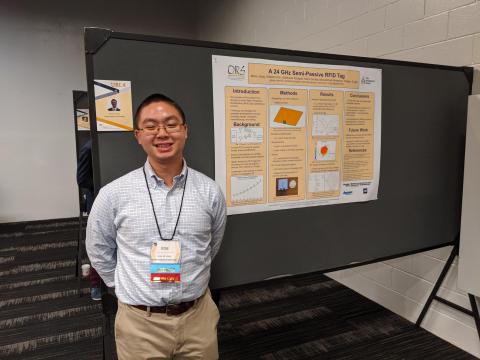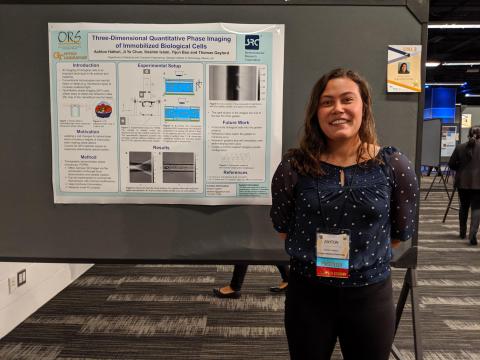Undergraduate researchers from the Georgia Tech School of Electrical and Computer Engineering (ECE) had a fine showing at SRC TECHCON 2019, held September 8-10 in Austin, Texas.
Undergraduate researchers from the Georgia Tech School of Electrical and Computer Engineering (ECE) had a fine showing at SRC TECHCON 2019, held September 8-10 in Austin, Texas. A total of seven ECE students from the Opportunity Research Scholars (ORS) Program participated in the conference, taking the first and third place prizes in the best student research presentation competition, with a third student asked to give an extended presentation on her work.
Daniel Yang won the first place prize for his poster entitled “Fully Inkjet-Printed Schottky Diodes.” A junior computer engineering major, Yang is advised by ECE Ph.D. student Aline Eid and ECE Ken Byers Professor Manos Tentzeris. This research is focused on fabricating Schottky diodes on flexible substrates using inkjet printing techniques and aims to provide a greater understanding of the feasibility and value of printing semiconductor devices.
Within the field of additive manufacturing, much work has been done in designing RF components and modules. Specifically, circuits have been printed which have valid RFID tags, ambient energy harvesters, and RF passive devices such as capacitors and inductors. However, little work has been done with additive manufacturing for the realization of active devices.
This work contributes to the already budding field of additive manufacturing and its relation to RF antennas and circuits. The current production of most semiconductor chips utilizes expensive manufacturing equipment and extremely technical production processes. Inkjet-printed devices on a flexible substrate require less expensive equipment, are more durable, and require less preparation and time.
Jesse Jiang won the third place prize for his poster entitled “24 GHz Semi-Passive RFID Tags.” He is a senior electrical engineering major, and he is advised by ECE Ph.D. student Mohammad Alhassoun and ECE Professor Gregory Durgin. RFID tags at lower frequencies have slower data transfer rates resulting from a narrow bandwidth. Designing an RFID tag at 24 GHz allows for much faster data rates over a shorter distance.
With the rapid improvements of the current wireless communication technologies such as 5G, it is important to keep up with the demand in technology. Higher frequency also allows for smaller size antennas. Because the antenna is the biggest component in an RFID enabled sensor, the space of the RFID sensors can be significantly reduced by designing an RFID tag at 24 GHz.
From an industrial perspective, this is important for wireless communication devices such as cellphones. Efficient use of space will have a dramatic impact on current wireless communication technologies and implementation of an RFID system that works with the current type of 5G technology may share the same antennas since they are operating at approximately the same frequency.
Ashton Hattori, a senior electrical engineering major, was also asked to give an extended presentation of her poster entitled “Three-dimensional Quantitative Phase Imaging of a Biological Cell.” She is a member of the Optics Laboratory, led by ECE Regents’ Professor Tom Gaylord; she is also advised by ECE Ph.D. student Yijun Bao. The primary applications of Quantitative Phase Imaging (QPI) techniques are in the medical and biological fields. They require the ability to precisely image a piece of biological matter on a cellular and subcellular level. Particularly in the medical field, this can be applied to the imaging of malignant cancer cells.
The ability to accurately observe cells allows for proper diagnoses and treatments of various diseases. Although the current techniques of 3D quantitative phase imaging are non-invasive and provide quantitative images of biological cells, they have several drawbacks. Most research in QPI is based on holographic optical tomography, which requires a stand-alone optical system. The additional equipment is costly and requires technical training to operate.
Holographic optical tomography also requires illumination to be coherent, both spatially and temporally, and coherent noise sources such as speckle interference may degrade the result. Another method based on axial scanning obtains multiple images by moving the focal plane through the object axis. Axial scanning utilizes the optical sectioning capability of incoherent light. However, without rotation of light beam or object, the resulting images are not isotropic due to missing information. The main objective of this work is to obtain a three-dimensional image of biological cells through non-invasive, label-free, low-cost quantitative phase microscopy.
SRC TECHCON is the annual flagship technical conference hosted by the Semiconductor Research Corporation (SRC). The conference draws top researchers, scientists, and a large field of students from across the United States to present cutting-edge research in the field of semiconductor electronics. The SRC is a global industrial technology research consortium. With its highly regarded university research programs, SRC plays an indispensable part in the R&D strategies of some of industry's most influential entities. Companies who are SRC members include Intel, IBM, Micron, Samsung, ARM, and Taiwan Semiconductor Manufacturing Company, Ltd.
Additional Images


